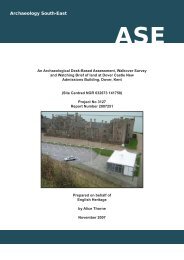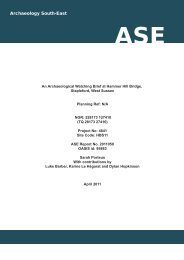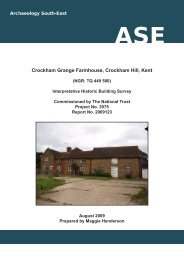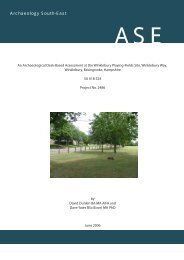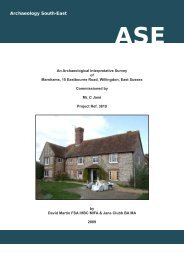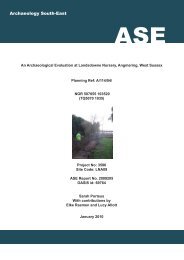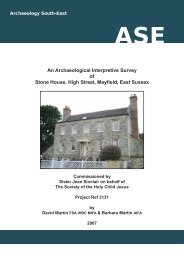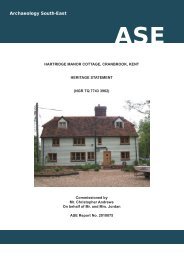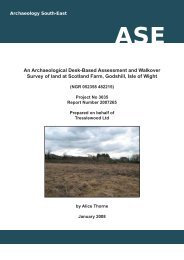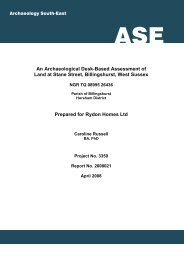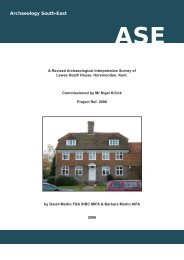Nos 1 & 2 Sprivers Cottages, Horsmondon, Kent - Archaeology ...
Nos 1 & 2 Sprivers Cottages, Horsmondon, Kent - Archaeology ...
Nos 1 & 2 Sprivers Cottages, Horsmondon, Kent - Archaeology ...
You also want an ePaper? Increase the reach of your titles
YUMPU automatically turns print PDFs into web optimized ePapers that Google loves.
<strong>Archaeology</strong> South-EastNo. 1 & 2 <strong>Sprivers</strong> <strong>Cottages</strong>, Horsmonden, <strong>Kent</strong>Interpretive Historic Building Survey / Rev 01/October 20073.0 LOCATIONNo.s 1 & 2 <strong>Sprivers</strong> <strong>Cottages</strong> are located approximately 1km south of thevillage of Horsmonden, <strong>Kent</strong> on the Lamberhurst Road (B2162) at gridreference TQ 694 396. Opposite the cottages is the <strong>Sprivers</strong> Mansion Estate(See Figure 1). The adjoining land is mostly farmland and orchards to thesouth with woodland to the north, which comprises part of the <strong>Sprivers</strong> Estate.The cottages are situated in the High Weald of <strong>Kent</strong> (AONB), the geology ofwhich is defined by the Cretaceous Wealden Series, comprising the Hastingsand Weald Clay Groups. The Hastings Group form the core of the HighWeald along the border of <strong>Kent</strong> with Sussex and comprise the Ashdown Beds,the Wadhurst Clay and the Tunbridge Wells Sands, a variable series ofdeposits importantly containing ironstone that was exploited from Romantimes to the 17 th century (Young 2004: 1). The BGS 1:50,000 series Sheet 304(Tenterden) locates <strong>Sprivers</strong> <strong>Cottages</strong> on the Tunbridge Wells Sand deposits.<strong>Sprivers</strong> <strong>Cottages</strong> are situated at 79.5m OD to the west of River Teise on anorth west facing slope that runs down into a tributary of the Teise.4.0 HISTORIC BACKGROUNDA limited amount of documentary research was undertaken at the Centre for<strong>Kent</strong>ish Studies, Maidstone, Maidstone Library and East Sussex RecordsOffice. Although <strong>Sprivers</strong> <strong>Cottages</strong> are located in <strong>Kent</strong> the property, as part ofthe <strong>Sprivers</strong> Estate, was in the ownership of the Courthope Family at the timeit was acquired by the National Trust with an endowment under the will ofRobert Courthope in 1966.The name Courthope is an old one in the north of East Sussex 1 , three men ofthat name being listed at Wadhurst in 1296. It is associated primarily with themanor and house of Whiligh in the parish of Ticehurst, which was held by thefamily since the early 15 th century. Courthope was also common north of the<strong>Kent</strong> border in the Middle Ages, e.g at Lamberhurst, Cranbrook, Goudhurstetc. The assumption is generally made that there was a common origin forthese early Courthopes, but the connections have not been definitively made 2 .The Hundred of Brenchley and Horsmonden was located in the lathe, or lest(one of the administrative districts into which <strong>Kent</strong> was divided, eachcomprising several hundreds 3 ) of Alyesford but is not mentioned inDomesday 4 . In 1272 as well as 1347 it was called the Hundred of Brenchley1 Background to the Courthope Family taken from the text of a talk given by Roger Davey (ESRO) atWhiligh on 5 th June 1996: The Courthope Papers (SAS/CO)2 ibid3 Lathes or lests set out in the Canterbury Monarchorum which is a Canterbury document containing adescription of the Canterbury estate and contains copy of the original returns from which Domesdaywas compiled (VCH Vol 3 p. 179)4 Page, W (ed). Victoria County History of <strong>Kent</strong> Vol 3. p. 1802



